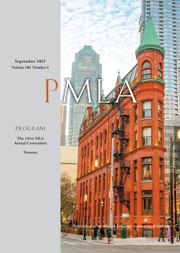No CrossRef data available.
Article contents
Benjamin Dreams of Anarchy
Published online by Cambridge University Press: 01 September 2025
Abstract
An abstract is not available for this content so a preview has been provided. Please use the Get access link above for information on how to access this content.
Information
- Type
- Theories and Methodologies
- Information
- Copyright
- © 2025 The Author(s). Published by Cambridge University Press on behalf of Modern Language Association of America
References
Works Cited
“The Angel of History: Walter Benjamin, Paul Klee and the Berlin Angels Eighty Years after WWII.” Staatliche Museen zu Berlin, www.smb.museum/en/exhibitions/detail/the-angel-of-history/. Press release.Google Scholar
Benjamin, Walter. The Arcades Project. Translated by Howard Eiland and Kevin McLaughlin, Belknap Press, 1999.Google Scholar
Benjamin, Walter. One-Way Street. Translated by Edmund Jephcott and Kingsley Shorter, Verso, 2021.Google Scholar
Benjamin, Walter. “Theses on the Philosophy of History.” Illuminations: Essays and Reflections, edited by Arendt, Hannah, translated by Harry Zohn, Schocken Books, 2007, pp. 253–64.Google Scholar
Benjamin, Walter. Toward the Critique of Violence: A Critical Edition. Edited by Peter Fenves and Julia Ng, Stanford UP, 2021.CrossRefGoogle Scholar
Derrida, Jacques. Khōra. Translated by Ian McLeod. On the Name, Stanford UP, 1995, pp. 89–130.CrossRefGoogle Scholar
Frere-Jones, Sasha. “Triple Double: Nathaniel Mackey’s Ongoing Game of Language.” Book Forum, June-July-Aug. 2021, bookforum.com/print/2802/nathaniel-mackey-s-ongoing-game-of-language-24514.Google Scholar
Goss, Steven. “A Partial Guide to the Tools of Art Vandalism: ‘If I Had a Hammer.’” Cabinet Magazine, no. 3, summer 2001, www.cabinetmagazine.org/issues/3/goss.php.Google Scholar
Hamacher, Werner. “Afformative, Strike.” Translated by Dana Hollander. Cardozo Law Review, vol. 13, no. 4, 1991, pp. 1133–57.Google Scholar
Klonk, Charlotte. Spaces of Experience: Art Gallery Interiors from 1800 to 2000. Yale UP, 2009.Google Scholar
Lepecki, André. Singularities: Dance in the Age of Performance. Routledge, 2016.CrossRefGoogle Scholar
Mackey, Nathaniel. From a Broken Bottle Traces of Perfume Still Emanate. New Directions Books, 2010.Google Scholar
Martínez Yépez, Heriberto. ¿Sueñan los marxistas con revoluciones aztecas? Poéticas del náhuatl y el México de Karl Marx y Walter Benjamin. 2018. U of California, Berkeley, PhD dissertation.Google Scholar
Moten, Fred. “Blackness and Nonperformance.” Afterlives: The Persistence of Performance, Museum of Modern Art, 25 Sept. 2015, New York City. YouTube, uploaded by The Museum of Modern Art, www.youtube.com/watch?v=G2leiFByIIg.Google Scholar
Moten, Fred. In the Break: The Aesthetics of the Black Radical Tradition. U of Minnesota P, 2003.Google Scholar
Nadal-Melsió, Sara. Europe and the Wolf: Political Variations on a Musical Figure. Zone Books, 2025.CrossRefGoogle Scholar
Reading Group. Independent Study Program, Whitney Museum of American Art, 10–22 July 2024.Google Scholar
Thomas, Greg. “Blame It on the Sun: George Jackson and Poetry of Palestinian Resistance.” Comparative American Studies, vol. 13, no. 4, 2015, pp. 236–53.CrossRefGoogle Scholar
Werckmeister, Otto Karl. Icons of the Left: Benjamin and Eisenstein, Picasso and Kafka after the Fall of Communism. U of Chicago P, 1999.Google Scholar

